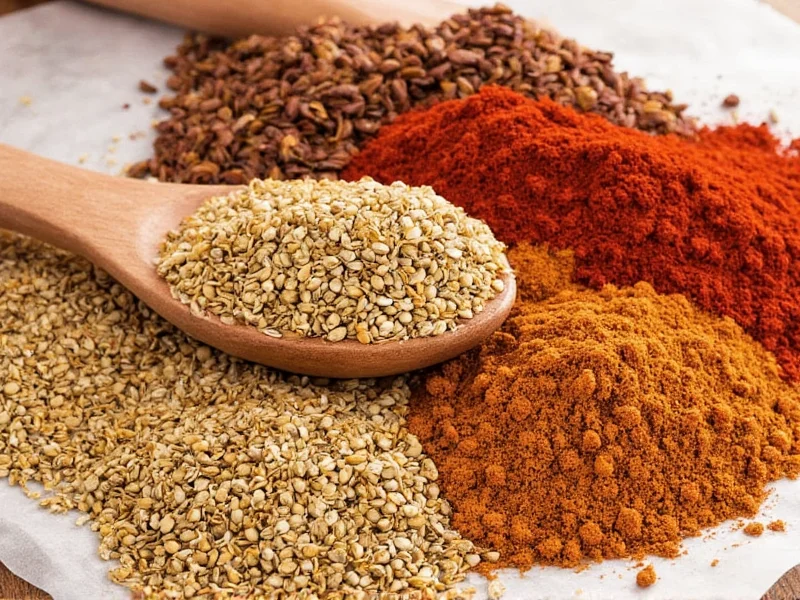Spices have shaped human civilization for millennia, traveling along ancient trade routes and transforming ordinary meals into culinary masterpieces. Whether you're a beginner cook or expanding your pantry, knowing fundamental spices unlocks endless cooking possibilities. This guide explores essential spices, their origins, flavor profiles, and practical applications in everyday cooking.
Understanding Spices: More Than Just Seasoning
Spices differ from herbs in that they come from plant seeds, bark, roots, or fruits rather than leaves. This distinction creates more intense, complex flavors that withstand cooking temperatures better than delicate herbs. Properly used, spices can elevate simple ingredients into extraordinary dishes while offering potential health benefits.
Essential Spices Every Kitchen Should Have
Building a versatile spice collection starts with these foundational options. Each brings unique characteristics that form the backbone of global cuisines:
| Spice | Flavor Profile | Common Culinary Uses |
|---|---|---|
| Cumin | Earthy, warm, slightly citrusy | Tacos, chili, curries, roasted vegetables |
| Paprika | Sweet, peppery, ranging from mild to smoky | Goulash, deviled eggs, rubs for meats, soups |
| Turmeric | Earthy, slightly bitter, peppery | Curries, rice dishes, golden milk, mustards |
| Cinnamon | Sweet, warm, woody | Baking, oatmeal, spiced beverages, Moroccan tagines |
| Black Pepper | Pungent, sharp, floral notes | Universal seasoning for meats, vegetables, sauces |
Regional Spice Traditions Worth Exploring
Global cuisines showcase distinctive spice combinations that define their culinary identities. Understanding these regional blends helps recreate authentic flavors:
- Middle Eastern: Sumac (tangy, lemony) features prominently in za'atar blends alongside thyme and sesame seeds. Used on meats, salads, and dips.
- Indian: Cardamom (citrusy, floral) appears in both sweet and savory dishes, from biryanis to chai tea. Often used whole or freshly ground.
- Mexican: Ancho chili powder (sweet, raisin-like) forms the base of many mole sauces and adobo blends, adding depth without excessive heat.
- Mediterranean: Oregano (robust, slightly bitter) shines in tomato-based dishes, grilled meats, and olive oil marinades.
Maximizing Flavor: Practical Spice Tips
Proper handling significantly impacts spice performance in your cooking:
Storage matters: Keep spices in airtight containers away from light and heat. Whole spices maintain potency for 2-4 years, while ground versions last 6-12 months. Test freshness by rubbing between fingers—if aroma is weak, it's time to replace.
Toasting technique: Briefly dry-toast whole spices in a skillet before grinding. This process releases essential oils, dramatically enhancing flavor complexity. Cool completely before grinding for best results.
Layering approach: Add hardy spices like cumin and coriander early in cooking to develop base flavors, then finish with delicate spices like paprika or saffron near the end to preserve their nuanced characteristics.
Creating Your Own Spice Blends
Custom blends offer superior flavor to pre-made mixes. Start with these simple combinations:
- Basic Curry Powder: 2 tbsp turmeric, 1 tbsp cumin, 1 tbsp coriander, 1 tsp ginger, 1/2 tsp cardamom, 1/4 tsp cloves
- Mediterranean Herb Mix: 2 tbsp oregano, 1 tbsp thyme, 1 tbsp rosemary, 1 tsp sage, 1 tsp garlic powder
- Smoky Rub: 2 tbsp paprika, 1 tbsp cumin, 1 tbsp garlic powder, 2 tsp onion powder, 1 tsp cayenne
Mix ingredients thoroughly and store in labeled jars. Adjust ratios to match your personal taste preferences—spice blending should reflect your culinary journey.
Expanding Your Spice Knowledge
As you become comfortable with basic spices, explore more specialized options like saffron (the world's most expensive spice), star anise (licorice-like flavor for braises), or sumac (tangy Middle Eastern seasoning). Remember that quality matters—purchase from reputable sources that guarantee freshness and purity. Small quantities of high-quality spices outperform large amounts of stale alternatives.
Experimentation remains the key to mastering spices. Keep notes on successful combinations and don't fear mistakes—many culinary discoveries happened through accidental pairings. Your spice journey transforms not just your cooking, but your entire relationship with food.
What are the most versatile spices for beginners?
Black pepper, garlic powder, cumin, paprika, and cinnamon form an excellent beginner's collection. These five spices cover sweet and savory applications across multiple cuisines. They work in everything from roasted vegetables and meats to baked goods and beverages, providing maximum versatility with minimal investment.
How can I tell if my spices are still fresh?
Test spice freshness by rubbing a small amount between your fingers and smelling. Fresh spices release strong, distinctive aromas immediately. If you barely detect scent or the fragrance seems dull, the spices have likely lost potency. Color also indicates freshness—vibrant hues suggest recent purchase, while faded appearance signals age.
Which spices pair well with chicken?
Paprika, garlic powder, onion powder, thyme, and rosemary complement chicken beautifully. For global flavors, try cumin and coriander for Middle Eastern dishes, five-spice powder for Asian preparations, or smoked paprika with oregano for Spanish-inspired recipes. Always balance bold spices with salt and pepper as foundational seasonings.
What's the difference between herbs and spices?
Herbs come from plant leaves (like basil, parsley, or cilantro), while spices derive from seeds, bark, roots, or fruits (such as cinnamon from tree bark or cumin from seeds). Herbs generally offer lighter, fresher flavors best added late in cooking, while spices provide deeper, more intense flavors that benefit from longer cooking times to develop fully.
Can I substitute ground spices for whole spices?
Yes, but with adjustments. Use 1/2 teaspoon ground spice for every teaspoon of whole spice called for in a recipe. Whole spices generally provide more complex, nuanced flavors when toasted and ground fresh, while ground versions offer convenience. For best results, toast whole spices briefly in a dry pan before grinding them for immediate use.











 浙公网安备
33010002000092号
浙公网安备
33010002000092号 浙B2-20120091-4
浙B2-20120091-4